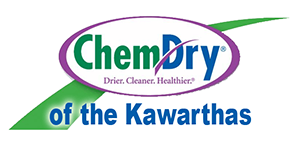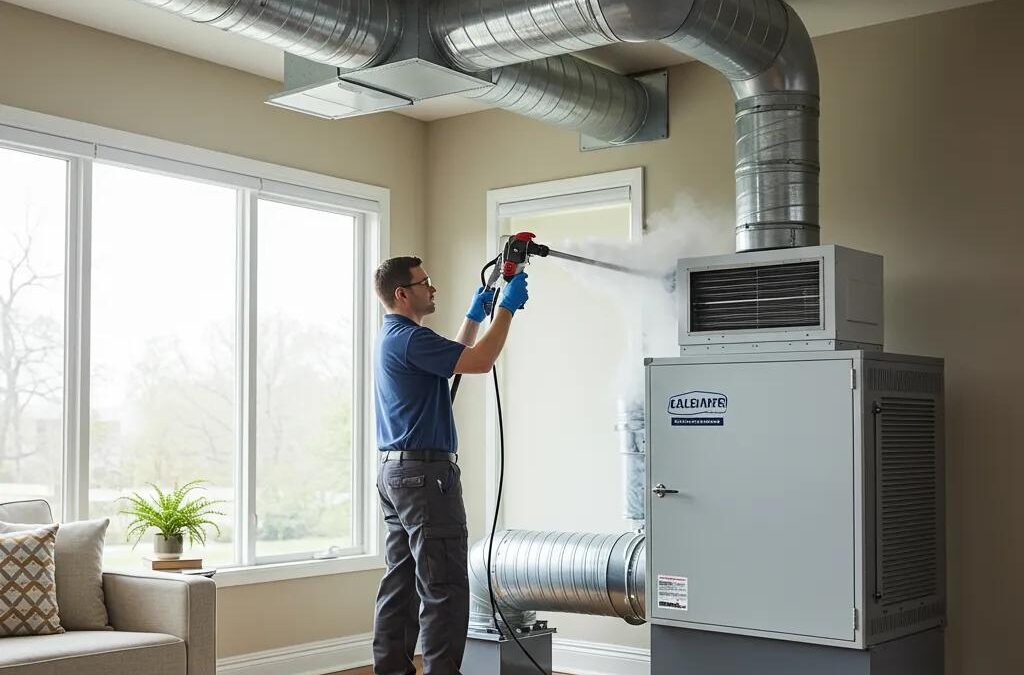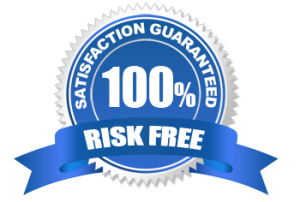Hidden allergens in your ductwork can trigger constant sneezing, coughing, and fatigue. But with expert air duct cleaning, you can quickly restore fresh, healthy air to your home. This guide reveals how dirty ducts fuel allergy symptoms, the tell-tale signs to look for, and why professional HVAC cleaning offers lasting relief. We’ll cover common allergens lurking in your ventilation, detail Chem-Dry Kawarthas advanced cleaning process, compare duct cleaning to portable air purifiers, discuss scheduling and costs across Canada, and highlight how Chem-Dry Kawarthas expertise ensures superior indoor air quality.
How Do Clogged Air Ducts Worsen Allergies and Harm Your Indoor Air?
When your air ducts are dirty, they trap and circulate allergens throughout your home, degrading your indoor air quality and triggering your immune system. Dust mites, pollen, pet dander, and mold spores accumulate in your vents, turning them into breeding grounds for irritants. Regular maintenance is crucial for your health and comfort.
What Common Allergens Thrive in Your HVAC System?

Professional inspections often find several types of allergens flourishing within unclean ductwork and HVAC components.
- Dust mites feed on skin flakes, embedding themselves in duct insulation and releasing potent allergens.
- Pollen grains enter your vents during peak seasons, coating duct interiors and spreading with every air cycle.
- Pet dander from cats and dogs clings to airflow surfaces and gets continuously recirculated.
- Mold spores can grow in damp ductwork if moisture isn’t properly managed.
These airborne irritants combine within your ducts, creating a significant burden that requires specialized cleaning to clear the air and provide symptom relief.
How Do Allergens Spread Through Your Home’s Ventilation System?
Your HVAC system circulates air through a network of supply and return ducts. As the blower fan pulls air in, it picks up allergens and distributes them throughout your living spaces via multiple vents. Over time, contaminants build up on duct walls and around filters, releasing concentrated clouds of allergens whenever your heating or cooling system runs. This highlights why cleaning the entire duct system, not just changing filters, is essential to stop persistent allergen circulation and ensure healthy airflow.
What Are the Health Consequences of Poor Indoor Air Quality for Allergy Sufferers?
When your indoor air quality suffers, allergy sufferers often face a wave of symptoms and related health issues. Breathing in dust mite proteins and mold spores can trigger intense sneezing, nasal congestion, dry coughing, and itchy eyes. Continued exposure can worsen asthma attacks, increase airway inflammation, and raise the risk of sinus infections. Poor air quality can also lead to chronic fatigue, headaches, and difficulty concentrating, demonstrating the widespread impact of airborne irritants. Addressing pollution from your ducts not only eases immediate allergy symptoms but also supports long-term respiratory health and daily well-being.
What Are the Signs Your Air Ducts Are Causing Allergy Flare-Ups?
Persistent indoor allergy symptoms often stem from contaminated ductwork, not just outdoor pollen or pet dander. Recognizing these signs can help you request professional assessments and avoid unnecessary medication adjustments.
Which Ongoing Allergy Symptoms Point to Dirty Air Ducts?
Frequent sneezing, itchy noses, and irritated throats that worsen indoors often indicate duct contamination. When your heating or cooling system runs, you might notice:
- Frequent sneezing fits, even with windows closed.
- Dry or persistent coughing linked to your HVAC system’s cycles.
- Red, watery eyes when air vents are active.
- Recurring sinus congestion that feels worse inside your home.
- Unexplained fatigue and occasional headaches.
If your symptoms consistently appear or intensify when your HVAC system is running, it’s time for a duct inspection to uncover hidden allergen sources and break the cycle of airborne irritation.
How Do Visible Dust and Lingering Odors Signal Air Duct Contamination?
Clues to dirty ducts include dust buildup around vent grilles and musty or stale smells when airflow begins. A fine layer of gray dust on vents and return grilles suggests significant dust accumulation. A damp, mildew-like odor points to mold or bacterial growth in moist areas of your system. These sensory warnings often precede noticeable increases in airborne allergens and signal the need for professional cleaning to eliminate hidden threats before they worsen allergy and asthma symptoms.
How Does Professional Air Duct Cleaning Provide Allergy Relief?
Professional air duct cleaning thoroughly removes accumulated contaminants from your entire ventilation system, significantly reducing airborne allergens. Using advanced negative-pressure equipment and HEPA filtration, our specialists extract deep-seated irritants right at the source, improving your indoor air quality and helping allergy sufferers breathe more easily.
What Is Chem-Dry’s Advanced Air Duct Cleaning Process?

Chem-Dry Kawarthas HVAC cleaning starts with a thorough inspection to pinpoint blockages, mold, and airflow issues. We then connect a high-efficiency HEPA vacuum system to your main duct openings, creating negative pressure to contain debris. Rotating brushes and air whips dislodge contaminants from supply and return lines. All captured particles are drawn into sealed containment units for safe disposal. Finally, we apply a non-toxic sanitizer to duct surfaces to prevent microbial growth and conduct a final check to ensure improved airflow and cleanliness.
How Does Air Duct Cleaning Reduce Allergens and Boost HVAC Efficiency?
Comprehensive duct cleaning eliminates dust mite habitats, pollen clusters, pet dander, and mold colonies that restrict airflow and make your HVAC system work harder. Clearing these obstructions can restore up to 60% of original airflow, reducing strain on your blower and potentially lowering energy consumption by 20–30%. Removing allergen sources also leads to cleaner vents and longer filter life, decreasing maintenance needs. This dual benefit for your health and your system’s efficiency means cleaner air and potential savings.
What Are the Key Benefits of Air Duct Cleaning for Allergy and Asthma Sufferers?
Homeowners and businesses dealing with allergies or asthma experience significant advantages from professional duct cleaning:
- Substantially fewer allergens, leading to less sneezing and congestion.
- Improved respiratory function, with fewer asthma flare-ups and less reliance on inhalers.
- Enhanced indoor air quality, providing fresher, cleaner air throughout your home.
- Extended HVAC system lifespan, resulting in lower energy bills and longer equipment life.
These combined results create a healthier living space where sensitive individuals can breathe freely and enjoy greater peace of mind.
How Often Should You Schedule Air Duct Cleaning for Optimal Allergy Relief?
Regular maintenance, tailored to your home’s specific conditions, ensures consistent indoor air quality and peak HVAC performance. Following expert recommendations helps allergy sufferers prevent allergen buildup before symptoms become severe.
What Factors Influence Cleaning Frequency for Allergy Sufferers?
Several conditions determine how often your ductwork needs professional attention:
- Having pets, as they continuously shed dander, increasing allergen levels.
- Signs of mold growth or musty odors, indicating microbial proliferation.
- Recent home renovations, which can introduce construction dust into your ventilation.
- The severity of your allergy or asthma conditions, requiring more frequent deep cleaning.
Considering these factors allows you to customize your cleaning schedule—from annual service for severe cases to every two to three years under typical conditions.
What Are the Recommended Cleaning Intervals According to Experts?
Leading industry organizations like NADCA and the EPA generally recommend air duct cleaning every two to three years for average households. Allergy sufferers, pet owners, or homes that have recently undergone renovations may benefit from annual service to prevent rapid allergen buildup and maintain symptom relief. Consistent filter changes combined with professional duct cleaning align with best practices for optimal air quality and reduced respiratory irritation.
Scientific Evidence on the Usefulness of Ventilation Duct Cleaning Although epidemiological studies indicate suggestive evidence that improperly maintained ducts… In summary, the necessity of duct cleanliness must be appropriately balanced against the probable…Is ventilation duct cleaning useful? A review of the scientific evidence, MS Zuraimi, 2010
How Does Air Duct Cleaning Compare to Air Purifiers for Allergy Management?
Air duct cleaning and portable air purifiers address indoor air concerns in different but complementary ways. Duct cleaning removes contaminant sources within your HVAC system, while purifiers filter the air in specific areas. Understanding their distinct roles helps you create a comprehensive defense against allergies.
Chem-Dry Kawarthas duct cleaning process targets entrenched allergens inside your vents, preventing their redistribution. Portable purifiers capture airborne particles in living spaces but have limited reach and require regular maintenance. Combining both strategies offers maximum coverage and continuous air freshness.
What Are the Differences Between Air Duct Cleaning and Air Purifiers?
Here’s a comparison of system-wide cleaning versus localized filtration:
| Solution | Scope of Treatment | Pollutants Targeted | Maintenance Frequency |
|---|---|---|---|
| Air Duct Cleaning | Entire HVAC duct network | Dust mites, pollen, mold, dander | Every 2–3 years |
| Air Purifiers | Individual rooms or zones | Particulate allergens and VOCs | Filter change quarterly |
Can Combining Air Duct Cleaning with Air Purifiers Maximize Allergy Relief?
Yes, integrating professional duct cleaning with strategically placed air purifiers creates a powerful, multi-layered defense. Duct cleaning removes settled allergens from their source, while purifiers capture any remaining airborne particles and gases in high-traffic areas. This combined approach ensures cleaner air entering your HVAC system and continuous localized filtration, leading to consistently lower allergen levels and enhanced relief for allergy sufferers.
When Should You Consider Adding an Air Purifier After Duct Cleaning?
After professional duct cleaning restores your home’s baseline air quality, adding air purifiers to bedrooms or main living areas can help maintain low particle levels between professional cleanings. Introducing a purifier shortly after duct cleaning ensures that it captures airborne irritants before they can resettle in your ducts, extending the benefits of your HVAC cleaning and supporting ongoing allergy management.
What Are the Typical Costs of Professional Air Duct Cleaning in Canada?
Investing in duct cleaning offers long-term health and energy savings, but understanding the cost factors helps you budget effectively. Prices can vary based on your home’s size and the scope of the service.
Which Factors Affect Air Duct Cleaning Prices for Allergy Relief?
Several variables influence pricing in Canada:
- Your home’s size and the number of duct branches affect the time and equipment needed.
- The level of contamination dictates the intensity of cleaning and any sanitizers used.
- The accessibility of your ducts (e.g., in crawlspaces or drop ceilings) impacts preparation and cleanup time.
- Additional services, such as dryer vent cleaning or antimicrobial treatments, will add to the overall cost.
By considering these factors, you can get accurate estimates and compare service offers based on clear criteria.
How Does Chem-Dry Kawarthas Provide Value Beyond Cost?
Chem-Dry Kawarthas adherence to NADCA standards and use of specialized HEPA-filtered vacuums emphasize quality over low prices. Our negative-air containment system prevents debris from escaping, and our certified technicians use industry-approved sanitizers without hidden markups. By focusing on thorough allergen removal and delivering measurable energy savings, Chem-Dry ensures a healthier home environment that pays for itself through reduced allergy triggers and lower utility bills.
Why Choose Chem-Dry Kawarthas for Your Air Duct Cleaning Needs in Canada?
Chem-Dry Kawarthas is your trusted partner for improving indoor air quality and providing allergy relief, thanks to our proven methods, certified expertise, and responsive local service.
What Makes Chem-Dry Kawarthas “The Healthy Home Authority”?
Chem-Dry Kawarthas reputation is built on five key strengths:
- Industry-leading equipment designed for deep contaminant extraction.
- HEPA-filtered vacuum systems that capture 99.97% of airborne particles.
- NADCA-compliant procedures ensuring comprehensive duct sanitation.
- Professional technicians trained in allergen-safe cleaning practices.
- Antimicrobial treatments and duct sealants specifically for allergy management.
These features solidify Chem-Dry Kawarthas position as Canada’s premier choice for maintaining healthy home ventilation.
How Does Chem-Dry Kawarthas Negative Air Cleaning Method Protect Your Home?
By creating a sealed vacuum environment at your duct openings, Chem-Dry Kawarthas negative air system prevents dislodged dust, mold spores, and pet dander from re-entering your living spaces. This containment strategy ensures all loosened debris is drawn into our capture units, guaranteeing a spotless HVAC system and safeguarding your indoor air quality from start to finish.
What Allergy-Specific Services Does Chem-Dry Kawarthas Offer?
In addition to standard duct cleaning, Chem-Dry Kawarthas offers specialized treatments to enhance allergy relief:
- Antimicrobial sanitizing solutions to inhibit mold and bacterial growth.
- Hypoallergenic deodorizing treatments to neutralize lingering odors.
- Duct sealing options to prevent unfiltered air bypass and dust infiltration.
These specialized services complement our core cleaning process to provide a comprehensive allergen reduction strategy for sensitive households.
What Are the Most Frequently Asked Questions About Air Duct Cleaning and Allergies?
Homeowners often seek clarity on how duct maintenance impacts symptom relief, the best times for service, and what to expect during a cleaning. Understanding these common questions will help you make informed decisions about investing in air duct cleaning.
Does Air Duct Cleaning Really Help with Allergies?
Yes, professional duct cleaning removes the primary sources of dust mites, pollen, pet dander, and mold spores hidden deep within your ventilation system. By extracting these particles at their source and applying antimicrobial treatments, cleaning significantly reduces airborne allergen levels, leading to fewer sneezing, coughing, and congestion episodes for sensitive individuals.
How Can I Tell If My Allergies Are Caused by Dirty Air Ducts?
Persistent allergy symptoms that worsen indoors or coincide with your HVAC system’s operation, visible dust around vents, and musty odors when the system starts are strong indicators. A diagnostic inspection by certified technicians can confirm contaminant buildup and directly link it to your allergy triggers, providing a clear path for effective treatment.
How Often Should Air Ducts Be Cleaned for Allergy Relief?
For most homes, professional cleaning every two to three years is sufficient to maintain optimal indoor air quality. However, allergy sufferers, pet owners, or homes with recent renovations may benefit from annual services to prevent rapid allergen accumulation and sustain symptom reduction.
Can Air Duct Cleaning Prevent Asthma Attacks?
While duct cleaning is not a substitute for medical treatment, removing allergen reservoirs from your ducts can reduce the airborne irritants that trigger asthma. Improved ventilation and lower particulate counts often lead to fewer asthma episodes and less reliance on rescue inhalers, supporting overall respiratory health.
What Should I Expect During a Professional Air Duct Cleaning Service?
Certified technicians will perform an initial assessment, seal duct openings using negative-pressure equipment, use specialized tools to agitate debris, capture all particles via HEPA filtration, and apply sanitizers to inhibit microbial growth. A final airflow test will confirm improved ventilation and the successful removal of allergens.
Breathe easier knowing that professional HVAC cleaning transforms hidden contaminant channels into clean, efficient pathways—delivering noticeable relief from allergy triggers and promoting a healthier home environment throughout Canada.





